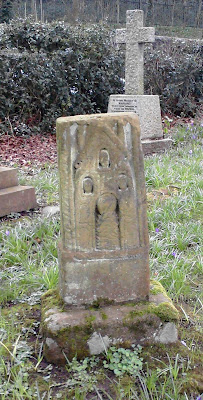
Digging into the hog back stone I uncovered this interpretation of the various images of the side that I photographed.
The overall form is as a house with a tiled roof supported by four figures, visible only on the hidden side.
On the side you can see we are on the side of light and life. The central figure is Sigurd in his human shape. There are the “Signs of Sigurd,” a tree with nine branches. “Yggdrasil” and birds two resting below it and two flying towards it. In addition to these birds there are three other animals and a fish. One of the animals is a horse in motion and has a very arched neck, looking rather like an Indian humped ox. It is a saddled horse, Grani, the horse belonging to Sigurd, who bowed his head to his master, as depicted here.
Sigurd was famed for his extreme bravery as a consequence of which he had an enormous task to perform. He had to slay the dragon Fafnir , a terrible, awesome scourge. It was only possible to do this at the dragon’s drinking place and in preparation for the deed, Sigurd had to dig a pit in which to hide so that he could thrust his sword into Fafnir as he passed over the top of the pit. The fearsome creature, however, was so huge that one pit would not be sufficient to contain the dragon’s blood and Sigurd would surely be drowned as it submerged him. To avoid this fate he had to dig a series of pits connected by ditches so that the blood could flow away without harming him.





